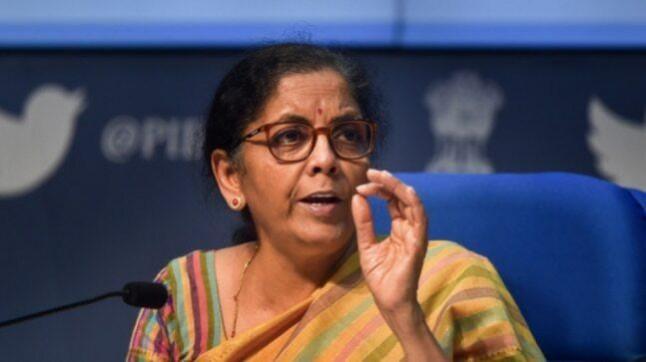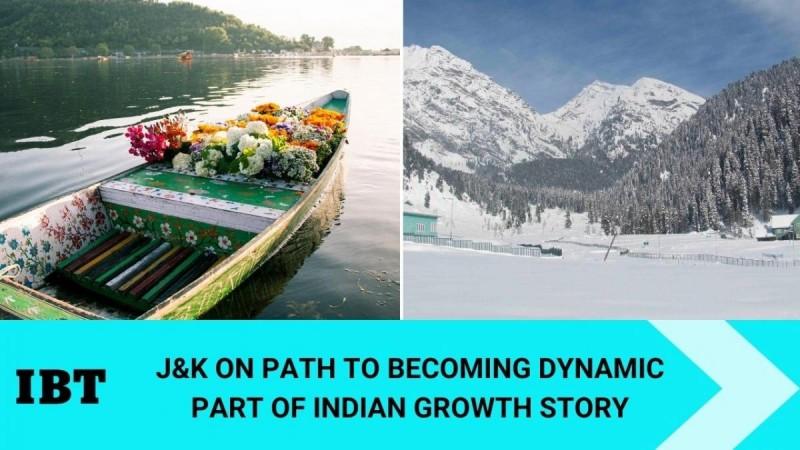On March 23, the Union Parliament passed the budget for Jammu and Kashmir. This was the third time the budget had been passed after the reorganisation of the erstwhile state of Jammu and Kashmir. While the budget itself stands out in some aspects, it is best looked at as a key element in a strategy of transformation that began three years ago with the writing down of the Articles 370 and 35A and full integration of the erstwhile state with the Union.
A plain look at the budget document reveals that the overall size of the budget underwent a sharp rise last year when it registered a nearly 51% increase over the previous year. The current year's budget size has seen a more modest increase of 11% but the cumulative increase since the reorganisation of the erstwhile state is a significant 67% accounting for an additional Rs 45,532 crores. On the tax collection side, J&K has recorded an impressive 25% higher tax collection. On the capital side too, J&K finds itself performing well above the national average in a year marked by a general trend of States underspending on capex. That these increases should appear in a financial year marked by the deadly waves of COVID are indicative of the overall improved governance and compliance mechanisms.
A closer look reveals that the total spending in the budget as a ratio of the GSDP of the UT for 2022-23 is projected to be more than 55%; the corresponding figure for a comparative hill state like Himachal Pradesh is only 28%. This high figure has been a distinct feature of the J&K economy for quite some time and indicates the abnormally high dependence of the economy on public expenditure. It is well known that despite generous assistance from the centre, the erstwhile State could not develop a strong private sector capable of generating either taxable revenues or productive employment. Quite naturally, public expenditure and public employment (J&K's 5 lakh strong workforce is among the highest-per-capita in the country) became the mainstay of the economy. Not surprisingly, the UT's own tax and non-tax revenues amount to only 23% of its total receipts- not even enough to foot its own salary bill. To compound problems, its expenditure on salaries and pensions comprises about 38% of total expenditure. While the UT has managed to increase its own tax resources in the previous fiscal, it is clear that the J&K budget still remains largely a Central Government funded affair.

Given this context, what is the transformative strategy that seeks to address the traditional weaknesses in the economy? How may the erstwhile State be weaned away from its dependence on an oversized government propped by Central Government largesse? And, how is the budget a key element of the strategy?
Development of the private sector has essentially three requirements viz. infrastructure, human capital and a favourable policy and regulatory environment.
The key to any economic revival and to ending the near-obsessive quest for government employment is the development of the private sector and it is important to view the budget through this lens. It can be argued that the development of the private sector has essentially three requirements viz. infrastructure, human capital and a favourable policy and regulatory environment.
Addressing major concerns and how
Let us look at how these concerns are being addressed.
First, the emphasis on capital expenditure is unmistakable. Even a casual look at the capex trends would indicate a sharp jump of nearly 179% when compared to 2020-21 figures. Thus capital expenditure has nearly trebled since the reorganisation of the state. While paradoxically this may further increase the proportion of Government expenditure in the UT's GSDP, in the short run there is no escape from this as infrastructure is necessary for a dynamic private sector.
Further, many of the expenditures being booked on large power projects, railways, national highways and large institutes are not reflected in the UT's capex. Thus viewed, the actual capital expenditure could be well above twice the figures reflected in UT's budget documents. Not surprisingly there is a flurry of large infrastructure projects getting initiated and completed. While hydropower generation capacity is set to double (adding not just to power availability but also to a healthy stream of income through power sales), the Zojila tunnel to Ladakh is on way to completion and the rail link to Kashmir- a project hanging fire since 2002- is all set to be opened this fiscal.

But growth is capex dependant only in part! In certain sectors, especially the service sectors like tourism, budgetary provisions, if spent smartly, can yield disproportionately high returns. While tourism has been traditionally associated with J&K, what is not widely known is that the former State never figured among the top ten states when it came to tourist arrivals either in absolute numbers or as a proportion of its population? Indeed if J&K were to receive as many tourists per head as Tamil Nadu does, its tourist arrivals would treble! Given that the employment multiplier for tourism is the highest across sectors any increase in tourist numbers would be the fastest way to generate "jobs with growth".
By providing support and resources for the development of 75 new destinations, it seeks to expand the tourism pie while bringing in more equity.
The current budget addresses this paradox. By providing support and resources for the development of 75 new destinations, it seeks to expand the tourism pie while bringing in more equity. Smart convergence with other public expenditures such as the culture department which seeks to revive traditional fairs and Sufi festivals, many of them in remote, lesser-known destinations or the J&K tourist village network scheme which incentivises local youth groups to promote rural tourism is expected to further add to this effort. Targeted public investment in roads and urban infrastructure is aimed at making the new locations more accessible and increasing the sustainable carrying capacity of these destinations. That this seems to be working is borne out by the figures - tourist inflow in J&K hit a 7-year high in November last year while 36,473 tourists visited the famed Tulip garden in a single day – March 27- the highest ever so far!
J&K hit a 7-year high in November last year while 36,473 tourists visited the famed Tulip garden in a single day – March 27- the highest ever so far!
Another critical sector is Horticulture. Although current yields per hectare are average or low, the sector generates considerable incomes for growers precisely because few other states in the country grow these fruits; (walnut, saffron for example). The budget's accent on horticulture addresses both the productivity and the income issues. The thrust on cold storage capacity expansion, increase in productivity of apple through high-intensity orcharding, support to high value and low volume agro-products like aromatic and cash crops and vegetables are all budget initiatives. When taken along with GI certification for saffron and other crops which is already underway, the sector holds great promise. Indeed if productivity is increased to international standards, it can lead to the quadrupling of the size of this sector and if supplemented by value addition to fruit (currently very low) it can significantly increase growth and employment.

Finally, the real Achilles heel of the J&K economy has been the lack of any significant industrial sector. To be fair, a number of assistance packages were tried out but earlier packages to aid or initiate industrialisation through tax exemptions attracted investment in projects that were designed only to take advantage of these subsidies. This led to one of the many paradoxes of the economy of the erstwhile State- sectors or units which received generous government assistance could not compete with the global economy unassisted while those which did not receive this largesse (e.g. handicrafts) actually thrived and expanded.
Playing to J&K's strengths
This paradox points out the need for an appropriate policy and one that is in sync with J&K's natural strengths.

It is in this context that the New Industrial Development Scheme for J&K announced in 2021 fits in the strategy of economic transformation. With a clear focus on employment generation and remote area growth to promote geographical equity, the scheme attempts an attractive set of incentives to kick start private sector investment. The promise of a higher incentive for investment in remote areas will not just help balanced development but also make possible the creation of several new industrial estates in areas that may not be suited for agriculture. J&K will thus be able to leverage its land abundance in a manner that it has been unable to hitherto. The accent on employment while allotting land will deter firms from using the subsidies and exemptions for "screwdriver" operations.
While all these elements will add to productive capacity, the uniqueness of the strategy lies in leveraging India's CEPA with the UAE (another off-budget element of transformation) to seek markets, investments and tourists. Given the proximity and familiarity of UAE with J&K, the Gulf Investment Summit seeks to build on these links and potentialities.
![Manoj Sinha chaired the Business Summit organized to showcase opportunities and boost investments in the UT of Jammu and Kashmir on the sidelines of J&K's participation in Dubai Expo 2020 at India Pavilion J&K's development attracts UAE's top conglomerates; a new dawn for UT [details]](https://data1.ibtimes.co.in/en/full/768650/jks-development-attracts-uaes-top-conglomerates-new-dawn-ut-details.jpg?h=450&l=50&t=40)
Another important element of the economic strategy is the targeting of public expenditure. While the nature of Public Investment now is increasingly realigned to draw in private investment its efficiency is now being used to eliminate the culture of languishing or indefinitely delayed projects. Thus while the road network is being planned to link newer industrial estates or newer tourist destinations or remote farms, J&K's immense hydro potential is being harnessed to complete power generation projects- some of which had been delayed for over a decade.
Financial inclusion, virtual connectivity and e-markets to support entrepreneurs and artisans and GI support for crops and vegetables are a few functional elements of the strategy. A reorientation of the academic as well as research programmes of Higher Education to train students for the new economy is already underway.
For too long has the J&K economy been weighed down by its constraints- many of which are simply the result of bad policies.
Fortunately, led by a clear policy direction, an economic transformation is underway.
Its public investment is now transparent, purposive, targeted and aligned to the goals of building a robust infrastructure for private capital. Its regulatory framework is becoming easy to navigate while its policy environment is changing to welcome private capital and seeks to leverage its traditional strengths. Its investment in human capital and skills is aimed at helping its demographic bulge ride on the opportunities thrown up by the multiplier of the above investments. A sustained effort by the security forces has ensured that acts of terror have been pushed below a critical level where they can no longer significantly impact the investment climate.
Jammu and Kashmir's role in India's development story will be distinct and supportive.
It will host an increasingly mobile India which is looking for destinations to tour and explore. It has the ability to produce the fruit and fruit products that will form part of the nutritious diet that India seeks to provide to all its citizens. For the more discerning Indian or any person in the world it has handicrafts that are product of millennia of experience and culture. It will eventually generate over one-third of India's hydropower. It also has the ability to host many of the IT, ITES, pharmaceutical, textile and electronics industries that it is uniquely positioned to attract. Its health, wellness and education ecosystem will be non-pariel in the country.
With a matrix of economic tools working in symbiotic convergence- public investment, industrial policy, transparent and targeted execution, central support, global markets, its new economic strategy holds promise in transforming the erstwhile State from being a sinkhole for India's scarce resources to a dynamic part of the Indian Growth story.
- Rohit Kansal is a senior IAS officer. He has been an Emerging Leaders Fellow of the Australia India Institute at the University of Melbourne
- Dipankar Sengupta is a Professor of Economics at the University of Jammu
Disclaimer: The views expressed by the authors are personal.
The piece originally appeared in Indian Express on April 7, 2022.

















